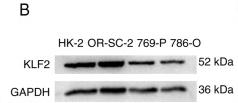KLF2 Antibody - #DF13602
| Product: | KLF2 Antibody |
| Catalog: | DF13602 |
| Description: | Rabbit polyclonal antibody to KLF2 |
| Application: | WB IHC |
| Cited expt.: | WB |
| Reactivity: | Human, Mouse, Rat |
| Prediction: | Chicken, Xenopus |
| Mol.Wt.: | 37kD, 52kD; 37kD(Calculated). |
| Uniprot: | Q9Y5W3 |
| RRID: | AB_2846621 |
Related Downloads
Protocols
Product Info
*The optimal dilutions should be determined by the end user. For optimal experimental results, antibody reuse is not recommended.
*Tips:
WB: For western blot detection of denatured protein samples. IHC: For immunohistochemical detection of paraffin sections (IHC-p) or frozen sections (IHC-f) of tissue samples. IF/ICC: For immunofluorescence detection of cell samples. ELISA(peptide): For ELISA detection of antigenic peptide.
Cite Format: Affinity Biosciences Cat# DF13602, RRID:AB_2846621.
Fold/Unfold
KLF 2; Klf2; KLF2_HUMAN; Krueppel-like factor 2; Kruppel like factor 2; Kruppel like factor; Kruppel like factor LKLF; Kruppel-like factor 2 (lung); Lklf; Lung krueppel like factor; Lung krueppel-like factor; Lung Kruppel like zinc finger transcription factor;
Immunogens
A synthesized peptide derived from human KLF2, corresponding to a region within the internal amino acids.
- Q9Y5W3 KLF2_HUMAN:
- Protein BLAST With
- NCBI/
- ExPASy/
- Uniprot
MALSEPILPSFSTFASPCRERGLQERWPRAEPESGGTDDDLNSVLDFILSMGLDGLGAEAAPEPPPPPPPPAFYYPEPGAPPPYSAPAGGLVSELLRPELDAPLGPALHGRFLLAPPGRLVKAEPPEADGGGGYGCAPGLTRGPRGLKREGAPGPAASCMRGPGGRPPPPPDTPPLSPDGPARLPAPGPRASFPPPFGGPGFGAPGPGLHYAPPAPPAFGLFDDAAAAAAALGLAPPAARGLLTPPASPLELLEAKPKRGRRSWPRKRTATHTCSYAGCGKTYTKSSHLKAHLRTHTGEKPYHCNWDGCGWKFARSDELTRHYRKHTGHRPFQCHLCDRAFSRSDHLALHMKRHM
Predictions
Score>80(red) has high confidence and is suggested to be used for WB detection. *The prediction model is mainly based on the alignment of immunogen sequences, the results are for reference only, not as the basis of quality assurance.
High(score>80) Medium(80>score>50) Low(score<50) No confidence
Research Backgrounds
Transcription factor that binds to the CACCC box in the promoter of target genes such as HBB/beta globin or NOV and activates their transcription. Might be involved in transcriptional regulation by modulating the binding of the RARA nuclear receptor to RARE DNA elements.
Ubiquitinated. Polyubiquitination involves WWP1 and leads to proteasomal degradation of this protein (By similarity).
Nucleus.
The 9aaTAD motif is a transactivation domain present in a large number of yeast and animal transcription factors.
Belongs to the krueppel C2H2-type zinc-finger protein family.
Research Fields
· Environmental Information Processing > Signal transduction > FoxO signaling pathway. (View pathway)
· Environmental Information Processing > Signal transduction > Apelin signaling pathway. (View pathway)
References
Application: WB Species: Mouse Sample:
Application: WB Species: Human Sample: HK-2 cells
Restrictive clause
Affinity Biosciences tests all products strictly. Citations are provided as a resource for additional applications that have not been validated by Affinity Biosciences. Please choose the appropriate format for each application and consult Materials and Methods sections for additional details about the use of any product in these publications.
For Research Use Only.
Not for use in diagnostic or therapeutic procedures. Not for resale. Not for distribution without written consent. Affinity Biosciences will not be held responsible for patent infringement or other violations that may occur with the use of our products. Affinity Biosciences, Affinity Biosciences Logo and all other trademarks are the property of Affinity Biosciences LTD.

























